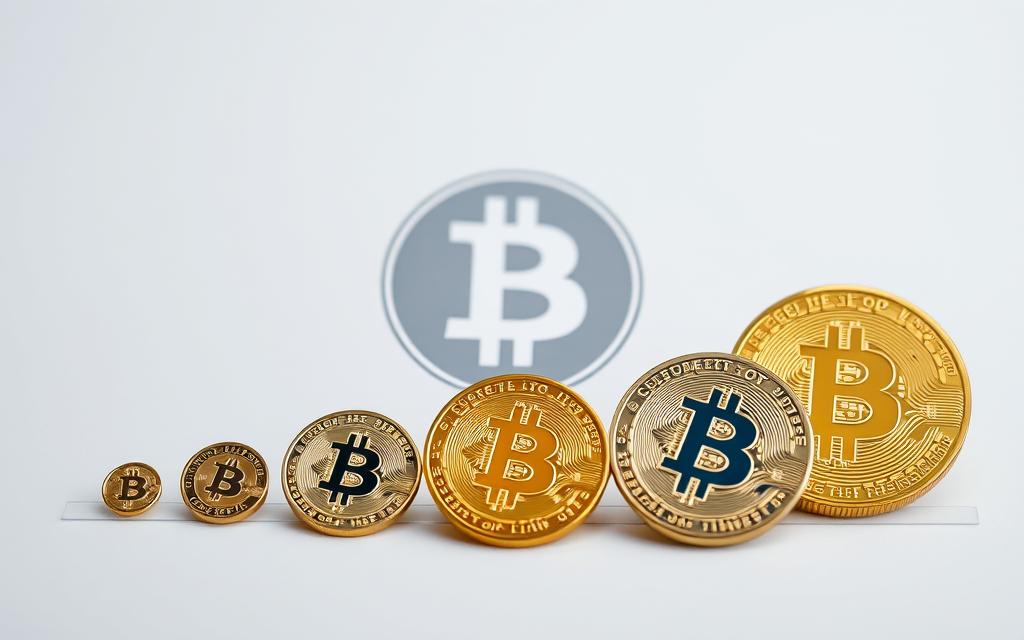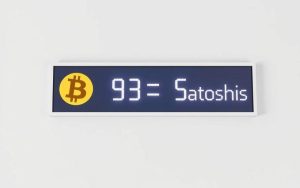Table of Contents
Bitcoin has revolutionized the way we think about money, and its divisibility is one of its most fascinating aspects. While most people know Bitcoin as a single unit, it can be broken down into smaller parts called “satoshis.”
The smallest unit of Bitcoin, satoshis enable microtransactions and small investments, making the cryptocurrency more accessible to everyone. Understanding the relationship between satoshis and Bitcoin is crucial for grasping its value and utility in various transactions.
In this article, we will explore the origin of satoshis, their mathematical relationship with Bitcoin, and how they facilitate everyday transactions and investments, making Bitcoin a more versatile unit of exchange.
Understanding Satoshis: The Smallest Unit of Bitcoin
The term “satoshi” has become an integral part of cryptocurrency vocabulary, symbolizing both a unit of measurement and a nod to Bitcoin’s enigmatic creator. This smallest unit of Bitcoin is fundamental to understanding the intricacies of digital currency transactions and investments.
What is a Satoshi?
A satoshi is the smallest unit of Bitcoin, equivalent to 0.00000001 BTC. This divisibility allows for microtransactions, making Bitcoin a versatile currency for various financial activities. The ability to transact in such small amounts has been crucial for the adoption of Bitcoin in different economies.
The Origin of the Name “Satoshi”
The name “satoshi” originates from Satoshi Nakamoto, the pseudonymous person or group credited with creating Bitcoin in 2008. The true identity of Nakamoto remains unknown, fueling ongoing debate about whether it was an individual or a group of people. Naming the smallest unit of Bitcoin after its creator reflects the cryptocurrency community’s respect for Nakamoto’s revolutionary contribution to digital finance.
| Term | Meaning | Relation to BTC |
|---|---|---|
| Satoshi | Smallest unit of Bitcoin | 0.00000001 BTC |
| Satoshi Nakamoto | Pseudonymous creator of Bitcoin | Founder |
| BTC | Bitcoin currency | Main unit |
The Relationship Between Bitcoin and Satoshi
Understanding the relationship between Bitcoin and satoshi is crucial for grasping the cryptocurrency’s full potential. The introduction of satoshis has enabled Bitcoin to be more versatile, allowing it to be used in a wider variety of economic scenarios.
How Many Satoshis Make One Bitcoin?
One Bitcoin is equal to 100 million satoshis. This divisibility into smaller units is a critical feature that distinguishes Bitcoin from traditional currencies. As quoted by Bitcoin’s creator, “The smallest unit of Bitcoin is the satoshi, allowing for microtransactions.”
Bitcoin’s Divisibility Explained
Bitcoin’s ability to be divided into 100 million satoshis makes it an attractive currency for both high-value transactions and everyday purchases. The divisibility feature helps solve the “unit bias” problem, encouraging adoption by making it possible to buy fractions of a Bitcoin. Key benefits include:
- Enabling microtransactions within the Bitcoin ecosystem.
- Allowing Bitcoin to adapt to various economic contexts.
- Making Bitcoin more accessible by not requiring the purchase of a whole coin.

How Many Bitcoins is a Satoshi?
To comprehend the worth of a satoshi, one must first understand its relation to Bitcoin. A satoshi is the smallest unit of Bitcoin, and its value is derived from the current price of Bitcoin.
The Simple Conversion Formula
The conversion between satoshis and Bitcoins is straightforward: 1 Bitcoin equals 100 million satoshis. Therefore, to convert satoshis to Bitcoins, you divide the number of satoshis by 100,000,000. For instance, if you have 50,000,000 satoshis, this equals 0.5 BTC.
Practical Examples of Bitcoin to Satoshi Conversion
Let’s consider some practical examples to illustrate the conversion. If Bitcoin’s price is $60,000, then 1 satoshi equals $0.0006. Here are a few scenarios:
- At a Bitcoin price of $50,000, 1 satoshi is worth $0.0005.
- If you own 0.01 BTC, you have 1,000,000 satoshis.
- For a $10 purchase when Bitcoin is $40,000, you need to send 25,000 satoshis.
| Bitcoin Price (USD) | Value of 1 Satoshi (USD) |
|---|---|
| $50,000 | $0.0005 |
| $60,000 | $0.0006 |
| $70,000 | $0.0007 |
Converting Satoshis to Bitcoin
To convert satoshis to bitcoin, one must first grasp the fundamental relationship between these two units of cryptocurrency. The process is essential for understanding and navigating the crypto market.
Step-by-Step Conversion Process
Converting satoshis to bitcoin involves a simple division process. Since 1 bitcoin equals 100 million satoshis, you can convert satoshis to bitcoin by dividing the number of satoshis by 100,000,000. For example, to convert 50 million satoshis to bitcoin, you would divide 50,000,000 by 100,000,000, resulting in 0.5 bitcoin.
| Satoshis | Bitcoin |
|---|---|
| 100,000,000 | 1 |
| 50,000,000 | 0.5 |
| 10,000,000 | 0.1 |
Using Online Satoshi Converters
For added convenience, many people use online Bitcoin to Satoshi calculators. These tools automate the conversion process, providing quick results without manual calculations. Popular cryptocurrency exchanges and wallet services often include built-in conversion tools that help users understand their holdings in different units.

Online satoshi converters provide instant calculations between satoshis, Bitcoin, and often fiat currencies. When selecting a converter, consider factors like reliability and real-time market data.
The Value of Satoshis in Real-World Currency
As Bitcoin continues to evolve, understanding the value of its smallest unit, the satoshi, in real-world currency becomes increasingly important. The value of one satoshi changes as Bitcoin’s price fluctuates. For instance, if Bitcoin’s current price is valued at $60,000, then 1 satoshi equals 0.0006 USD (or 0.06 cents).

Calculating Satoshi Value in USD
To calculate the value of satoshis in USD, one must first know the current market price of Bitcoin. The formula is straightforward: satoshi value = (Bitcoin price in USD / 100,000,000). Using this formula, investors can easily determine the value of their satoshis at any given time.
Price Fluctuations and Their Impact on Satoshi Value
Bitcoin’s price volatility directly affects the value of satoshis. During market fluctuations, the value of satoshis changes proportionally. This volatility creates both opportunities and challenges for investors and users. For example, during bull markets when Bitcoin prices rise, the value of satoshis increases, potentially making microtransactions less practical. Conversely, during bear markets, the decreased value of satoshis can make Bitcoin more accessible for smaller transactions and new investors.
As emphasized by a renowned cryptocurrency expert, “The key to navigating the crypto market is understanding how price movements affect the smallest units of currency.” This insight highlights the importance of staying informed about market trends for anyone making an investment in Bitcoin.
- The dynamic nature of Bitcoin’s price affects satoshi value, making it essential for users to stay updated.
- Understanding these fluctuations is crucial for making informed decisions about buying, selling, or transacting in Bitcoin.
- Some businesses adjust their satoshi prices frequently to maintain stable currency pricing, addressing the challenge of volatility.
Other Bitcoin Measurement Units
Beyond the satoshi, Bitcoin has other measurement units that cater to different transaction sizes and contexts. This flexibility is crucial for Bitcoin’s usability across various scenarios, from microtransactions to large investments.
Understanding mBTC, μBTC, and Other Units
Bitcoin’s divisibility is reflected in its various measurement units. For instance, mBTC (millibitcoin) equals 0.001 BTC, and μBTC (microbitcoin or bits) equals 0.000001 BTC. These units facilitate easier comprehension and handling of Bitcoin amounts in different contexts.

When to Use Different Bitcoin Units
The choice of Bitcoin unit largely depends on the transaction size and context. Here are some general guidelines:
- Whole bitcoins are typically used for large investments or significant purchases.
- mBTC is suitable for medium-sized transactions.
- Satoshis are ideal for small purchases or microtransactions.
| Unit | Value in BTC | Typical Use Case |
|---|---|---|
| 1 BTC | 1 | Large investments |
| 1 mBTC | 0.001 | Medium transactions |
| 1 satoshi | 0.00000001 | Microtransactions |
As Bitcoin adoption grows, the standardization of these units for specific use cases is likely to follow, similar to traditional currency practices.
Stacking Sats: A Bitcoin Investment Strategy
As Bitcoin continues to grow in popularity, the strategy of stacking sats is becoming more widespread. This approach involves accumulating satoshis over time, leveraging the potential long-term appreciation of Bitcoin.
Understanding Stacking Sats
“Stacking sats” refers to the practice of incrementally investing in Bitcoin by buying small amounts of satoshis regularly. Advocates like Jack Dorsey promote this strategy, emphasizing its potential to build substantial holdings over time without requiring large upfront capital. By focusing on satoshis rather than whole Bitcoins, investors can overcome the psychological barrier of Bitcoin’s high unit price.
Benefits of Accumulating Satoshis
Stacking sats offers several benefits, including mitigating the impact of Bitcoin’s price volatility through dollar-cost averaging and encouraging a long-term investment mindset. Regular small investments can be more sustainable than large one-time purchases, making Bitcoin accessible to a broader range of investors.
| Benefits | Description |
|---|---|
| Dollar-Cost Averaging | Reduces the impact of price volatility |
| Long-Term Mindset | Encourages sustained investment over time |
| Accessibility | Makes Bitcoin investment feasible for more investors |

Conclusion: Why Satoshis Matter for Bitcoin Adoption
As we’ve explored, satoshis are crucial for Bitcoin’s functionality and adoption, serving as the smallest unit of Bitcoin. Satoshis have made Bitcoin accessible to people worldwide, allowing it to function as both a store of value and a medium of exchange. By breaking Bitcoin down into manageable parts, satoshis enable transactions in small amounts, making Bitcoin accessible across different economic backgrounds and regions of the world.
The ability to own and transact in satoshis rather than whole bitcoins helps overcome the psychological barrier of Bitcoin’s high unit price, potentially accelerating adoption. For more information on what a satoshi is, you can visit https://www.bankoncube.com/post/what-is-a-satoshi. As Bitcoin continues to gain value, satoshis will likely become increasingly important for everyday transactions and microtransactions, expanding its utility beyond just a store of value.
FAQ
What is the smallest unit of Bitcoin?
The smallest unit of Bitcoin is called a Satoshi, named after Bitcoin’s pseudonymous creator, Satoshi Nakamoto. One Satoshi equals 0.00000001 BTC.
How do I convert Satoshis to Bitcoin?
To convert Satoshis to Bitcoin, you can use an online Satoshi converter or divide the number of Satoshis by 100 million, as there are 100 million Satoshis in one Bitcoin.
What is the value of one Satoshi in USD?
The value of one Satoshi in USD fluctuates with the price of Bitcoin. To calculate it, you can divide the current Bitcoin price by 100 million.
What does "Stacking Sats" mean?
“Stacking Sats” is a Bitcoin investment strategy that involves accumulating Satoshis over time, taking advantage of the cryptocurrency’s divisibility and potential for long-term growth.
Are there other units of measurement for Bitcoin besides Satoshis?
Yes, other units include milliBitcoin (mBTC), microBitcoin (μBTC), and more. These units are used for different purposes, such as simplifying transactions or expressing smaller amounts.
Why is understanding Satoshis important for Bitcoin adoption?
Understanding Satoshis is crucial because it allows users to appreciate Bitcoin’s divisibility, making it more accessible for microtransactions and investment, thus driving adoption.
Can I buy a fraction of a Bitcoin?
Yes, you can buy a fraction of a Bitcoin. In fact, you can purchase as little as one Satoshi, making it possible to invest in Bitcoin even with small amounts of money.
How does the price of Bitcoin affect the value of Satoshis?
The price of Bitcoin directly affects the value of Satoshis. As the Bitcoin price fluctuates, so does the value of Satoshis, since one Satoshi is 0.00000001 BTC.









